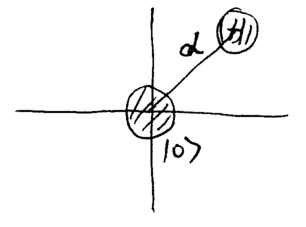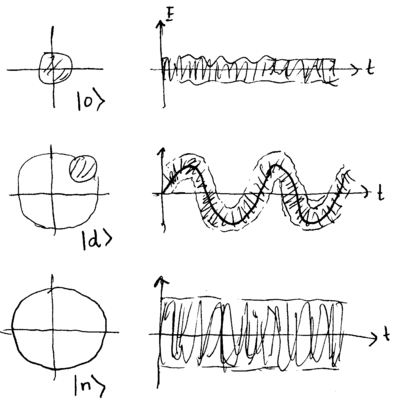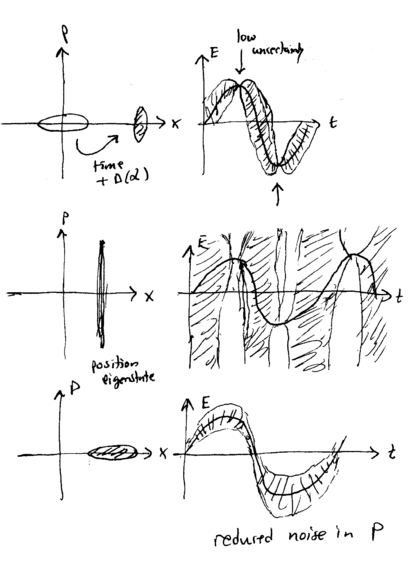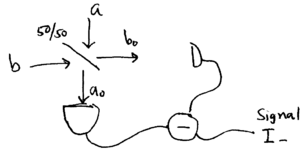Difference between revisions of "Non-classical states of light"
imported>Ichuang |
imported>Ichuang |
(No difference)
| |
Revision as of 14:41, 18 March 2007
Contents
Non-classical light
One of the most special properties of the coherent state is that its fluctuations in and are equal, and minimal, meaning that it satisfies the Heisenberg limit . However, satisfying this limit does not require equal noise in the two conjugate variables; it is certainly permissible for noise in one to be larger than the other. Such states can, in principle, be quite useful, for example, if a measurement only involves , and excess noise in can be disregarded. In this section, we define such squeezed states, and explore their physical properties. We begin with classical squeezing, then define squeezed states of a quantum simple harmonic oscillator, describe how squeezing can be experimentally detected, then show how it can be useful in a quantum experiment: teleportation.
Classical squeezing
We are interested in the dynamics of the simple harmonic oscillator, and it is useful to obtain some intuition about what is possible from considering the classical oscillator. Consider a particle in the potential
The equations of motion for this particle, have the solution
where , , and are constant. This motion is circular:
Suppose a small, "parametric" driving force is added, analogous to kicking while on a swing. For a swinging pendulum, this force could be applied by tugging gently up and down on the string as the pendulum oscillates back and forth. Let this force be applied at twice the frequency of the natural harmonic motion, such that the potential becomes
where is small. substituting Eq.(\ref{eq:c2-ansatz}) into the equation of motion
approximating , and averaging away terms rapidly oscillating at , we obtain new approximate equations of motion
with solutions
This shows that the circular motion in phase space evolves under the parametric drive to become elliptical:
What is the ultimate limit of this classical squeezing effect? The answer turns out to be quantum noise, which enforces the Heisenberg uncertainty limit, .
Squeezed states: quantum
A quantum simple harmonic oscillator excited by a parametric drive at will also generate squeezed states. Physically, such a process corresponds to a "nonlinear" interaction which involves photons interacting with each other, via the medium they are transported through or generated from. One important physical process that generates squeezed states of light is known as the optical parametric oscillator, which we may think of as being an atomic system that is driven at , and produces two photons at and , due to cascaded decay from two equaly spaced energy levels:
Such a process can be described by the Hamiltonian
where acts on the output mode at frequency , and the input mode, at frequency . If the input light is a strong coherent field, then to a good approximation, we may replace and by a classical variable in this Hamiltonian, obtaining
where denotes the strength of the input pump light, and for simplicity, we fix in the following. Motivated by this Hamiltonian for the optical parametric oscillator, we may define a mathematical operator which produces squeezed states:
Note that the operator in the exponent has the form , where is Hermitian, so is manifestly a unitary transform. What does do? A useful mathematical technique for dealing with is to understand how it transforms operators in the Heisenberg picture. For example,
Let us use
as dimensionless Hermitean operators for position and momentum. Under the squeezing operator, using the above expansion, it is straightforward to show that position and momentum transform to become:
This shows that squeezes noise from the position, and adds noise to the momentum, of a harmonic oscillator state. Consider, for example, the effect of this operator on the vauum state, , which we call the "squeezed vacuum" state. The plot of this squeezed vacuum is:
\noindent Note that since is unitary, it leaves invariant, so is a minumim uncertainty state, since is. We can explicitly compute what is as follows:
Note that this state only has nonzero probability amplitude to have an even number of photons! Another usful representation for the squeezed vacuum is in terms of coherent states:
This representation allows us to depict useful limits, such as when , the inifinite squeezing limit, giving a state we may call :
and similarly, we may define
These two states have plots which are of infinite extent, horizontally (for ) and vertically (for ), indicating that infinitely squeezed states are position and momentum eigenstates:
How can squeezing produce finite valued position and momentum eigenstates? Physically, a simple harmonic oscillator such as an oscillating pendulum is given a finite momentum or position by displacing the pendulum, and the same is done to produce squeezed states of and . We define the mathematical displacement operator as
It is straightforward to show (by expanding the exponential, for example), that this operator has the property that
such that the displaced vacuum state satisfies
Since is thus an eigenstate of , it must be the case that . The displacement operator displaces the vacuum state to become a coherent state :
Using the displacement operator, squeezed states with finite momentum and position can thus be described, for example, by . What do these states look like, both in the representation, as well as their electric field? Recall that the vacuum, coherent state, and number states look as follows:
A displaced, partially squeezed state, a near-position eigenstate, and a near-momentum eigenstate correspondingly look like this:
Note how the squeezed states attain electric fields which are, at times, very low in either amplitude or phase uncertainty. By employing these states in the right kind of interferometer, as we shall see later, this reduced noise level can be used to improve the precision of certain measurements.
Homodyne detection
How can we experimentally detect if a state is squeezed? Ideally, squeezing could be detected by measuring the noise level in and . However, photodetectors are square-law detectors which sense light intensity, meaning photon number, and not quadrature field components. Nevertheless, the and field components can be detected if the input light is first transformed by beating it with a reference signal of fixed phase. Intuitively, this follows the principle upon which many early radios worked: by mixing a signal with a reference oscillator , the cosine and sine components and can be picked out. This method is known as homodyne detection, because it involves mixing with a reference at the same frequency as the signal. With radio frequency signals, a diode is used to mix signal and reference; the nonlinearity of the diode produces an output which is to first order, the product of the signal and reference. Mixing of light frequency signals is done with a beamsplitter. Consider a 50/50 beamsplitter with the signal input into port , and the reference into port , and detectors placed at the two outputs:
The beamsplitter mixes the two input ports, performing a unitary transform that relates the output port operators and to the input port operators and ,
- <math>\begin{array}{rcl}
a_0 &=& U_{bs} a U_{bs}^\dagger = \frac{a+b}{\sqrt{2}} \\ a_0 &=& U_{bs} a U_{bs}^\dagg





![{\displaystyle {\begin{array}{rcl}x(t)&=&r(t)\cos \left[{\omega _{0}t-\theta (t)}\right]\\&=&c(t)\cos \omega _{0}t+s(t)\sin \omega _{0}t\,,\end{array}}}](https://wikimedia.org/api/rest_v1/media/math/render/svg/ed1126f0314b124b847a7002315b85c3ebe46531)



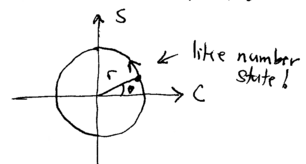
![{\displaystyle V(x)={\frac {1}{2}}m\omega _{0}^{2}x^{2}\left[{1+\epsilon \sin 2\omega _{0}t}\right]\,,}](https://wikimedia.org/api/rest_v1/media/math/render/svg/edff86a2e3d12726d0213449d5ae7228eefca2d0)

![{\displaystyle {\ddot {x}}=-\omega _{0}^{2}\left[{1+\epsilon \sin 2\omega _{0}t}\right]x(t)\,,}](https://wikimedia.org/api/rest_v1/media/math/render/svg/c1e3676b6d9d447947628c0faa1a8c06be12dca6)




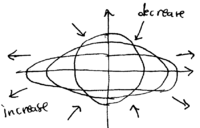










![{\displaystyle S(r)=\exp \left[{-{\frac {r}{2}}(a^{2}-{a^{\dagger }}^{2})}\right]\,.}](https://wikimedia.org/api/rest_v1/media/math/render/svg/fa8fdf415b0d7a2de52f5ac51d302e2e76b6e0cd)


![{\displaystyle S(r)=\exp[iA]}](https://wikimedia.org/api/rest_v1/media/math/render/svg/36c5cb1ef21f7609c7218e2a536b288698c49569)

![{\displaystyle {\begin{array}{rcl}S(r)xS(r)^{\dagger }&=&e^{iA}xe^{-iA}\\&=&x+[iA,x]+{\frac {[iA,[iA,x]]}{2!}}+\cdots \,,\end{array}}}](https://wikimedia.org/api/rest_v1/media/math/render/svg/436a68184a6b6900e56cbb70cbdc460340bcc08a)




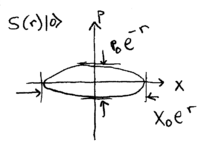


![{\displaystyle {\begin{array}{rcl}S(r)|0\rangle &=&\sum _{k=0}^{\infty }{\frac {1}{k!}}\left[{-{\frac {r}{2}}(a^{2}-{a^{\dagger }}^{2})}\right]^{k}|0{\rangle }\\&=&{\frac {1}{\sqrt {\cosh r}}}\sum _{n=0}^{\infty }{\frac {\sqrt {(2n)!}}{2^{n}n!}}(\tanh r)^{n}|2n{\rangle }\,.\end{array}}}](https://wikimedia.org/api/rest_v1/media/math/render/svg/5ddf7dcb3b019cbc045a92cdab3abbc501b1ad3f)







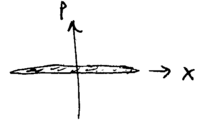
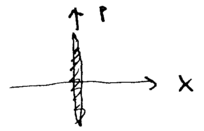



![{\displaystyle D(\alpha )=\exp \left[{\alpha a^{\dagger }-\alpha ^{*}a}\right]\,.}](https://wikimedia.org/api/rest_v1/media/math/render/svg/b380dce7a8eb51fea894d41eddb7f38170b2b89c)





